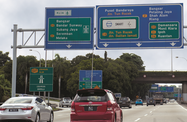Malaysia is at the forefront of a $485m infrastructure fund to forge closer transportation and logistics services between members of the ASEAN community.
With 600m people spread across 10,000 islands in 10 countries, the ASEAN has long been heavily influenced by its transport infrastructure, and the paucity of road, rail, sea and air links within and between member states has long kept shipping prices high and challenged even the most robust economic development.
Malaysia, located in the geographic centre of the regional grouping, is no exception: transport costs between Peninsular Malaysia and Borneo are relatively expensive, and Sabah and Sarawak remain underdeveloped. Thus, as ASEAN moves to boost cooperation amongst its members, a new infrastructure financing mechanism is one of its prime areas of focus.
The ASEAN Infrastructure Fund, announced in September 2011, will receive $335m from nine member states, with the remaining $150m coming from the Asian Development Bank (ADB). Of the ASEAN countries, Malaysia is the largest single contributor to the fund, providing $150m, followed by Indonesia with $120m, according to the ADB.
Malaysia is also taking a non-financial leadership role as well: the country’s leadership in setting up the fund and hosting a series of high-level task force meetings from 2011 onwards. The fund will also be incorporated as a limited liability company in Malaysia.
More than $13bn will be used to finance infrastructure projects through 2020, with 70% of the loans coming from ADB. The remaining $4bn will be provided by member states. Six infrastructure projects, selected both for their economic rate of return and their potential for poverty reduction, will be financed every year. ADB will oversee the fund, monitoring for efficiency and transparency.
The fund represents one concrete implementation of the Master Plan on ASEAN Connectivity (MPAC), which was signed in 2010 in Ho Chi Minh City. The document sets forth a vision for achieving both “physical” and “institutional” connectivity within the region, prioritising a number of specific projects and initiatives, according to the plan.
These include the West Kalimantan-Sarawak interconnection project, which would connect the electricity grids in the Indonesian and Malaysian parts of Borneo. The $150m project, which would increase grid reliability and allow Sarawak to import cheaper hydroelectricity from Kalimantan, should begin in 2013. Also being planned is the $490m Melaka-Pekanbaru interconnection, which features a 52-km submarine cable under the Strait of Malacca between Malaysia and Indonesia.
The two flagship land transport projects emphasised under the master plan are the ASEAN Highway Network (AHN), and the Singapore-Kunming Rail Link (SKRL). The AHN is an attempt to connect, standardise and improve the highway systems of member states, making intra-regional transport cheaper and more efficient.
Malaysia is a standout success in this regard, as all 2242 km of its designated total transit routes (TTRs) are at least of Class III standard, the ASEAN minimum, according to MPAC documents. Investment in the AHN will focus on Cambodia, Lao PDR, Myanmar and Vietnam, but improved roads will benefit Malaysian firms looking to do business in the region.
Another key focus of the MPAC is the Singapore-Kunming Rail Link, envisioned as a seamless network connecting ASEAN to the rest of Asia through the Chinese city of Kunming. There are currently seven “missing links” within the SKLR, covering a total of 1279 km, again mostly in the area of Vietnam and Thailand.
Malaysian companies are already anticipating reaping the economic benefits from this network. National rail operator Keratapi Tanah Melayu (KTM) is looking to set up operations in Thailand, and plans to offer both cargo and passenger services. The continued expansion of SKLR would only enhance the profitability of such an expansion. One of KTM’s goals in the passenger sub-sector is the development of a niche tourism sector featuring long-haul scenic train travel.
ASEAN’s infrastructural challenge is steep – by some estimates, its member countries will need to spend $60bn over the next 10 years to enable the economic growth that its governments are targeting. But these investments should help boost intra-regional trade from its current, rather weak levels. Only 25% of the total trade conducted by ASEAN member states in 2010 was internal, compared to 50% for NAFTA and 60% for the EU, according to media reports.
Tighter economic integration will not only boost economic growth, but should also help insulate the region from slowdowns originating in OECD countries. True decoupling will only be achieved when the ASEAN region can build an enabling infrastructure of transport and communications.

